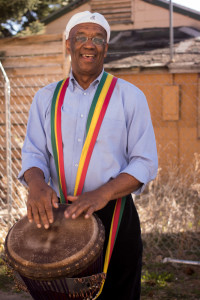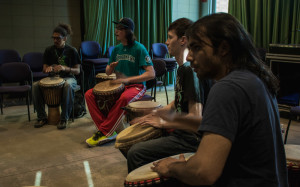Tags
Related Posts
Share This
The African Drum Ensemble’s Upcoming Concert
Every Monday and Wednesday afternoon from 2 -5 p.m. the O’Shaughnessy Performance Space fills with echoing poly-rhythms of West African drums. The African Drum Ensemble is practicing for its upcoming, end-of-the year concert.
The African Drum Ensemble first started when Santa Fe University of Art and Design was called the College of Santa Fe, and was taught by a couple who still live in Santa Fe. Since then there has been a progression of people who have taken on the class, but Fred Simpson—its current instructor—has taught it since the last year of the College of Santa Fe and still teaches it now.

Fred Simpson, the instructor for the African Drum Ensemble. Photo by Richard Sweeting.
Simpson, known as Baba to his students, decided to start teaching the ensemble after his predecessor gave up his position to study at University of New Mexico.
“I’d already been here for 10 years, so I was the logical successor,” Simpson says.
Jonah Rydin, a member of the African Drum Ensemble, enjoys being in the ensemble because, unlike other ensembles, the African Drum Ensemble allows any student of any skill to participate.
“Usually people join ensembles because they play a certain instrument or can sing in a certain technique,” Rydin explains. “But with the African Drum Ensemble, most people go into it not know what they’re doing. It’s a very collective ensemble because we’re all in it together, doing the same thing with the same goal.”
By learning to play African drums, students are able to gain a deeper understanding of rhythm because African music is often poly-rhythmatic, which means that two, three or four rhythms are played all at once—usually in different meters. This type of music often defies Western notation because there is always a mixture in the meters.
“You can’t say the rhythm is in 4, or the rhythm is in 3,” Simpson explains. “The meter could be in a 4/4 time, but the soloists playing over the 4/4 could be in 3, so it’s not clear cut.”
Unlike Western rhythms that are notated on a horizontal time line, African rhythms are circular because they run in cycles.
The African Drum Ensemble uses drums from West Africa, specifically Djembe (a goblet shaped drum) and Dunum (cylindrical base drums that carry the rhythms in sets of two or three) from Guinea or Mali. And, although it’s certainly possible to expand to different types of African drums, Simpson prefers to stay in one area because African music is so varied. It would require an entirely different course for each type of new drum.
“Each part of Africa has their own language and they have their own drums because the drums are a reflection of the language the people speak,” Simpson says. “So people are able to say sentences by playing out certain rhythms on drums.”
This is not dissimilar to Rydin’s belief that drumming and rhythms are ingrained in all people due to the naturally occurring rhythms in the human body.

The African Drum Ensemble practices in O’Shaughnessy hall before their big performance. Photo by Richard Sweeting
“I feel like rhythms refers back to bodily rhythms like heartbeats, stomping and dancing,” Rydin says. “Drumming is something that has always been deeply grounded in humanity, and with a bunch of people and different patterns it can be really interesting.”
In the future, Simpson hopes to have more instruments and more students to play. He would eventually like to take a trip to Africa so his students can see the drums played in their proper context.
Rydin is excited about the upcoming concert. Despite the stress of finals looming over their head, Rydin feels confident about performing in the ensemble.
“It’s weirdly calming to be able to make tons of noise with lots people in a collective space,” Rydin says. “People will be able to see what we’ve been working towards and I think it’ll mark how far we’ve come.”
The African Drum Ensemble’s concert will be held at 7:30 p.m., May 6 at the Forum.






 Jackalope Magazine is the student magazine of Santa Fe University of Art and Design. Building on the interdisciplinary nature of our education, we aim to showcase the talent of our university and character of our city.
Jackalope Magazine is the student magazine of Santa Fe University of Art and Design. Building on the interdisciplinary nature of our education, we aim to showcase the talent of our university and character of our city.
Recent Comments